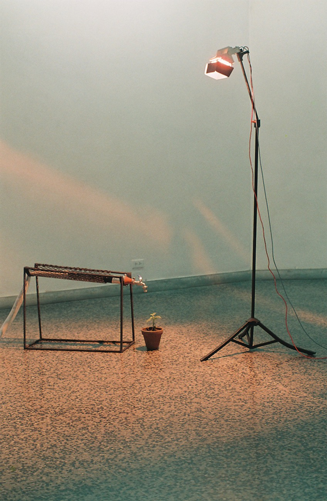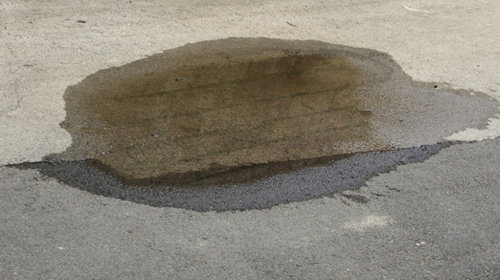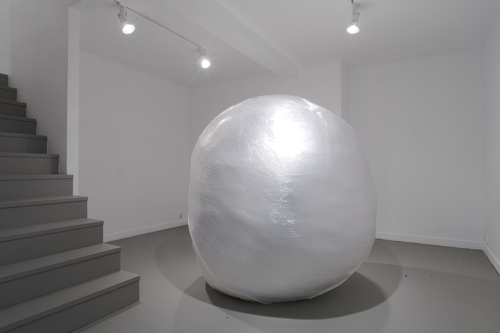Adam Barbu
All images by the artist.
The work of Cuban artist Wilfredo Prieto speaks a language of form that challenges how we think about the relationship between art, culture and politics in the time of neoliberal global capitalism. Prieto creates works that range in scale from the miniature to the everyday to the expansive, while maintaining a conceptual practice that reaches across mediums such as sculpture, installation, photography and video. With perhaps his most monumental, iconic work Much Ado About Nothing (2003), two large industrial water tanks are parked outside of the museum with loud engines running throughout hours of operation. A long hose runs throughout the different galleries and reaches to the top floor, letting out a continuous drip to sustain the life of a small houseplant. Curator Thibaut Verhoeven has described the work as tracing an “extreme energy input for an extreme minimal output.” For Prieto, this movement from maximization and minimization becomes a way to enter into broader discussions on social and environmental ethics. His works interrupt modernist tropes of aesthetic purity and formal singularity by re-reading fragments of the modernist vocabulary in a tension between extraction and abstraction, and subsequently, plasticity and naturalism. Reaching across topics such as art history and mass energy consumption, the following interview focuses on Prieto’s idea that the political potential of art emerges through the possibility of constructing “sustainable ideas.”

Estaque (Pond), 2008, petrol, iron tanks, frog, water, variable dimensions. Photo courtesy of the artist.
Adam Barbu: Can you introduce readers to your practice, and in a general sense, speak about your relationship to the contemporary Cuban cultural policy?
Wilfredo Prieto: My work tries to knock on different doors. I would say that I work with experience, with everything that surrounds me. The everyday is my study material. Therefore, it’s very difficult for me to give my work a specific form, or to conceptualize it in a particular way.
I have always been very positive about Cuban cultural policy, which is in fact the base of my artistic formation. It is a system that I view as being very healthy.
AB: Using minimalism as a starting point, I am curious about your interest in the tensions between addition and reduction, the commonplace and the universal, and the perishability and permanence of form. Can you speak about the role these dualities play in the making of your work? How do you define the relationship between minimalism and neoliberal critique?
WP: I don’t believe in minimalism as a visible influence on my job. “Minimalism” was something that belonged to another moment, another generation. I think in terms of the need for an effective language, an exact, direct language – a language for today. This may indeed trace the need for a confusion of politics in the time of megacalculated social, cultural and political strategies that begin in one direction and ultimately go in another. I think that art is necessarily paradoxical, counterproductive movement whereby the universal answer can also be found in local readings. I don’t believe much in the permanence of the form, but I do in the permanence of the ideas.
AB: To this point, could speak about the relationship between art, politics and ambiguity?
WP: Art is a language of ambiguity in and of itself, and I am a being who lives in a determined era. Yet all objectivity starts from a reality that I share but must first translate. I reflect experiences, worries and reflections in a determined moment. We are in an era where politics, economy and information are the predominant power, so any reflection from an aesthetic or philosophical point of view refers to them. Furthermore, when one attempts to do something hermetically aesthetic, it becomes something directly political. And here I would stress that the risks of artistic production are intensified when they become complacent with the prevailing market trends.

Much Ado About Nothing (installation view), 2003, electric generator, water pipe, hose, cables, lamp, plant, variable dimensions. Photo courtesy of the artist.
AB: What role does waste plays in your conceptual practice? It seems that any attempt to define this term depends on how we interpret “the natural.” These ideas are clearly at stake when we consider the broader environmental implications of our culture of hyper-consumption, specifically those damaging effects that occur beneath our routinized, granted points of visual access. A particular work that seem important to this discussion is Much Ado About Nothing, recently presented during your retrospective at the S.M.A.K. museum in Ghent, Belgium.
WP: Waste is an important aspect of reality and plays a large part in my work. Reality and art are structured by waste. In short, the plant depends on the productive excess of the machine. It assumes an incalculable physical effort in order to achieve intangible results. This piece signals toward utopia, toward the poetic and the absurd, and the ridiculous with a bit of kitsch.
I would stress, my intention is not to explicitly comment about environmental politics. The work refers to a more philosophical relationship between the natural and artificial and stages the coexistence of these two realities in a same space. Overall, then, I am interested in an abstract engagement with environmental politics, exploring the topic it from the existential depth of human development.

Holy Water (installation view), 2009, holy water, variable dimensions. Photo courtesy of the artist and Annet Gelink Gallery.
AB: Here, I would like to focus on your works that use or evoke the elemental “purity” of water. Two works that interest me here are Holy Water (2009), and Crocodile Tears (2011), both of which appear to the viewer as accumulated spreads of water on the gallery floor. Can you tell us about the motivation behind these works?
WP: In this case the material is not exactly the same – neither are “purely” water. For example, in Crocodile Tears I use artificial chemical eye drops to symbolize tears. Conversely, the water in Holy Water is a real symbolic composition based on religious beliefs, on faith. What is important for me is the meaning and memory of the material. I am interested in the different cognitive possibilities that exist and coexist in a same element. In this essential reduction, which is both a minimization and maximization of the materiality of “water,” we are able to expose a whole mode signification that is broader than the thing itself.
AB: Hypothetically, it seems that when amalgamated into one larger volume, one drop, one glass “half full,” one puddle of “tears” or “holy water,” is seemingly interchangeable with the next. A drop is essentially the ocean, insofar as it remains anonymous – its orientation depends on the meaning we embed in it. How do you understand the relationship between formal singularity and this contingency of signification? Here, your work The more that is added, the less you can see (2011) also comes to mind.
WP: Yes, this idea coincides with a recent exhibition of work in Amsterdam. The focus for this project was to move closer to an utterance of pure form by exploring the essence and excess of each element; the circle, the square, and so on. For example, with the work Hero (2011), I use the motif of the crystal cube – an object that has been repeated and reproduced a thousand times in art history and belongs to any artist and any moment. I attempted to lean towards the neutrality of form, and yet what became absolutely important to me was how each piece of this exposition had a different specificity and personality. Whether in the case of the drop of water, the circle or the square, we find that the same element can take on opposite meanings. All it takes to shift this reception of form is the subtle incision of a concept.

The more that is added, the less you can see (installation view of Speaking Badly About Stones), 2011, cling film. Photo courtesy of Michel Burez and Annet Gelink Gallery.
AB: Jacques Rancière writes that politics and aesthetics must be read as together, and not as opposites since they both enact the “redistribution” of the sensible.[1] Furthermore, in an interview conducted near the end of his life, Felix Gonzalez Torres stated, “We were not born with a set of aesthetic rules in our hands, were we? Aesthetics are not about politics; they are politics themselves. And this is how the ‘political’ can be best utilized since it appears so ‘natural.’”[2] How do you interpret Gonzalez-Torres’ remark?
WP: In the middle ages, artistic production served religion. Nowadays, our environment is the economy, information and politics. Artists reflect this situation. Therefore aesthetic production is political. Felix is a vertebral influence on my work, not only as a fellow Cuban, but also in terms of his effective and necessary use of language to counter the cultural violence of his time.
AB: To this point, I am interested in your take on the relationship between aesthetic production and capitalist appropriation. How far can the artist reach in effecting change in neoliberal society? What does it mean for an artist to be either politically conscious or politically disinterested? Is it possible to be either fully?
WP: Yes, art has always been a proportionally direct element to political and social transformations, both in counterproductive-conscious or passive-unconscious ways. Art is the link that oxygenates and refreshes reality (and as previously stated, I make a weary distinction against market art). Historically, these transformations have always occurred, from the Church painters, to the court, and so on. Here, an influence that emerges structurally in my work is the concept of Verfremdung from Bertolt Brecht – that the imitation of reality creates a level of estrangement that has a disruptive potential. In my work this distancing occurs from a simple, yet complex interruption expressed directly from within the language of image and form. I consider myself a realistic artist. And being realistic today also means being subversive and even partially cynical.
AB: What projects are you working on today?
WP: I continue working on a number of investigative research projects. This new work takes on more of an engineering character, such as placing a monumental sculpture in the center of Cuba, or creating a one-kilometer highway in the form of the mathematical symbol for infinity. Certain other projects require a more direct experimentation in the field of physics, for example a work titled Cara o Cruz (“Head or Tails), whereby a coin will remain in the constant levitation of a toss. At the same time I am still very interested in materiality and all its symbolic possibilities, tracing these possibilities at the level of the everyday and exploring the ways in which these subtle interruptions can take on broader social, political, environmental, and ethical responsibilities.
Notes
[1] Rancière, Jacques. The Politics of Aesthetics: The Distribution of the Sensible. (London: Continuum, 2004). 2.
[2] Spector, Nancy. Felix Gonzalez-Torres. (New York: Solomon R. Guggenheim Museum, 1995). 13.
Wilfredo Prieto was born in Sancti-Spiritu, Cuba in 1978. He is considered one of the most influential young artists to emerge from Cuba in recent years. Prieto studied at Instituto Superior de Arte, Havana and has held residencies at Gasworks, London; Le Grand Cafe, St. Nazaire, France; John Simon Guggenheim Foundation, New York and the Kadist Art Foundation, Paris. His latest solo exhibitions were held at S.M.A.K., Gent (2014), NMAC Foundation, Cadiz (2013), Sala de Arte Publico Siqueiros, Mexico (2012), 11th Havana Biennale, J and Calzada, Havana (2012), Praxis, ARTIUM, Vitoria (2011), Kunsthalle Lissabon, Lisbon (2011), and the Dia Art Foundation, New York (2007). In 2008, Prieto was the recipient of prestigious Cartier Award.
Adam Barbu is an independent writer and curator currently living between Ottawa and Toronto. He has organized contemporary art exhibitions nationally and internationally that explore themes of cultural memory, the politics of spectatorship, and alternative modes of public engagement. For November 2014 he was the curator in residence at the Parque Cultural de Valparaíso (Valparaíso, Chile) and was recently awarded the Middlebrook Prize for Young Curators. His current critical research focuses on queer theory, “post AIDS” discourses, and early minimalist art.